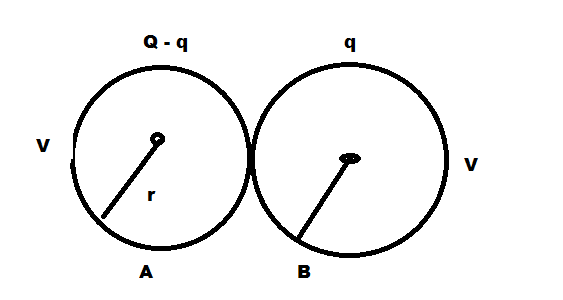You have four identical conducting spheres: A, B, C, and D. In each scenario, sphere A starts with a charge of +Q whereas B, C, and D start out with no net charge, and then the spheres are touched to each other and separated in the order described. Any spheres not in contact are held very far away. For each scenario, give the final charge of sphere D as a whole number fraction of Q. For example, if you decide that the final charge of sphere D is 4, enter 1 in the numerator and 7 in the denominator. Remember! Before each scenario begins, spheres A, B, C, and D are reset to charges of +Q, 0, 0, and 0 again. Scenario 1: A andB touch and are separated, then A and C touch and are separated, then A and D touch and are separated. Qp =
You have four identical conducting spheres: A, B, C, and D. In each scenario, sphere A starts with a charge of +Q whereas B, C, and D start out with no net charge, and then the spheres are touched to each other and separated in the order described. Any spheres not in contact are held very far away. For each scenario, give the final charge of sphere D as a whole number fraction of Q. For example, if you decide that the final charge of sphere D is 4, enter 1 in the numerator and 7 in the denominator. Remember! Before each scenario begins, spheres A, B, C, and D are reset to charges of +Q, 0, 0, and 0 again. Scenario 1: A andB touch and are separated, then A and C touch and are separated, then A and D touch and are separated. Qp =
Advanced Engineering Mathematics
10th Edition
ISBN:9780470458365
Author:Erwin Kreyszig
Publisher:Erwin Kreyszig
Chapter2: Second-order Linear Odes
Section: Chapter Questions
Problem 1RQ
Related questions
Question
100%

Transcribed Image Text:You have four identical conducting spheres: A, B, C, and D. In each scenario, sphere A starts with a charge of +Q whereas
B, C, and D start out with no net charge, and then the spheres are touched to each other and separated in the order
described. Any spheres not in contact are held very far away. For each scenario, give the final charge of sphere D as a whole
number fraction of Q. For example, if you decide that the final charge of sphere D is , enter 1 in the numerator and 7 in
the denominator.
Remember! Before each scenario begins, spheres A, B, C, and D are reset to charges of +Q, 0, 0, and 0 again.
Scenario 1: A and B touch and are separated, then A and C touch and are separated, then A and D touch and are separated.
Scenario 2: A and B touch and are separated, then B and C touch and are separated, then C and D touch and are separated.
Qp =
Scenario 3: A and D touch and are separated, then D and C touch and are separated, then D and A touch and are separated,
then A and B touch and are separated.
Expert Solution
Step 1
Given:-
When two spheres are touched each others it remains at same potential (V) and the charge rearrange to do the same and equal potential at each of them.
Potential of sphere surface A :
Therefore,

Trending now
This is a popular solution!
Step by step
Solved in 5 steps with 1 images

Knowledge Booster
Learn more about
Need a deep-dive on the concept behind this application? Look no further. Learn more about this topic, advanced-math and related others by exploring similar questions and additional content below.Recommended textbooks for you

Advanced Engineering Mathematics
Advanced Math
ISBN:
9780470458365
Author:
Erwin Kreyszig
Publisher:
Wiley, John & Sons, Incorporated

Numerical Methods for Engineers
Advanced Math
ISBN:
9780073397924
Author:
Steven C. Chapra Dr., Raymond P. Canale
Publisher:
McGraw-Hill Education

Introductory Mathematics for Engineering Applicat…
Advanced Math
ISBN:
9781118141809
Author:
Nathan Klingbeil
Publisher:
WILEY

Advanced Engineering Mathematics
Advanced Math
ISBN:
9780470458365
Author:
Erwin Kreyszig
Publisher:
Wiley, John & Sons, Incorporated

Numerical Methods for Engineers
Advanced Math
ISBN:
9780073397924
Author:
Steven C. Chapra Dr., Raymond P. Canale
Publisher:
McGraw-Hill Education

Introductory Mathematics for Engineering Applicat…
Advanced Math
ISBN:
9781118141809
Author:
Nathan Klingbeil
Publisher:
WILEY

Mathematics For Machine Technology
Advanced Math
ISBN:
9781337798310
Author:
Peterson, John.
Publisher:
Cengage Learning,

